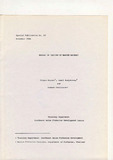| dc.description.abstract | It was in 1893 that an eminent Danish fisheries biologist, C.G. Joh Petersen, first tagged plaice by attaching to them a numbered bone disc for the purpose of estimating the exploitation rate and the size of population. From this beginning, tagging and marking techniques have become an indispensable tool in the study of fish populations. Indeed, there are now very few species of fish of major commercial importance which have not been tagged or marked by one means or another, and the technique has been extended to molluscs, crustaceans, and sea mammals. Its applications range from a simple estimation of fish migrating in connection with the discrimination of a unit stock of a species, to vitally important estimation of the abundance of stock, growth and mortality rate of exploited fish populations. | en |

